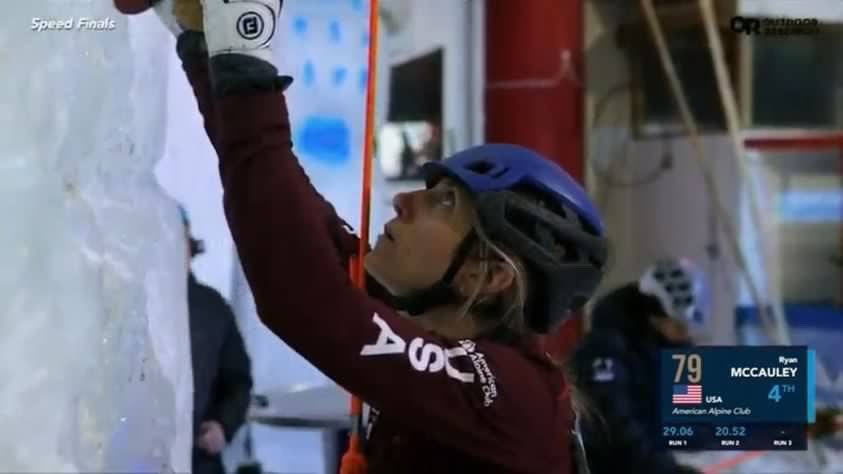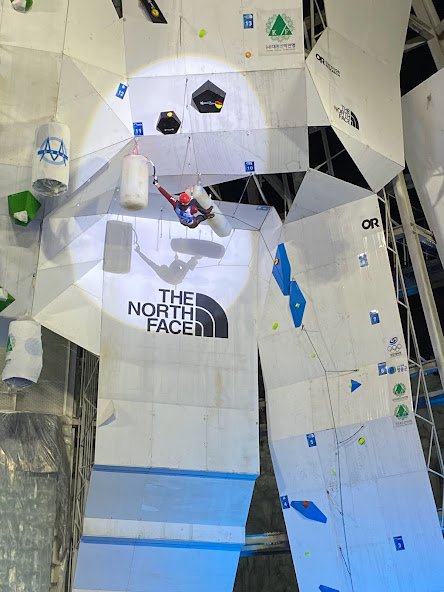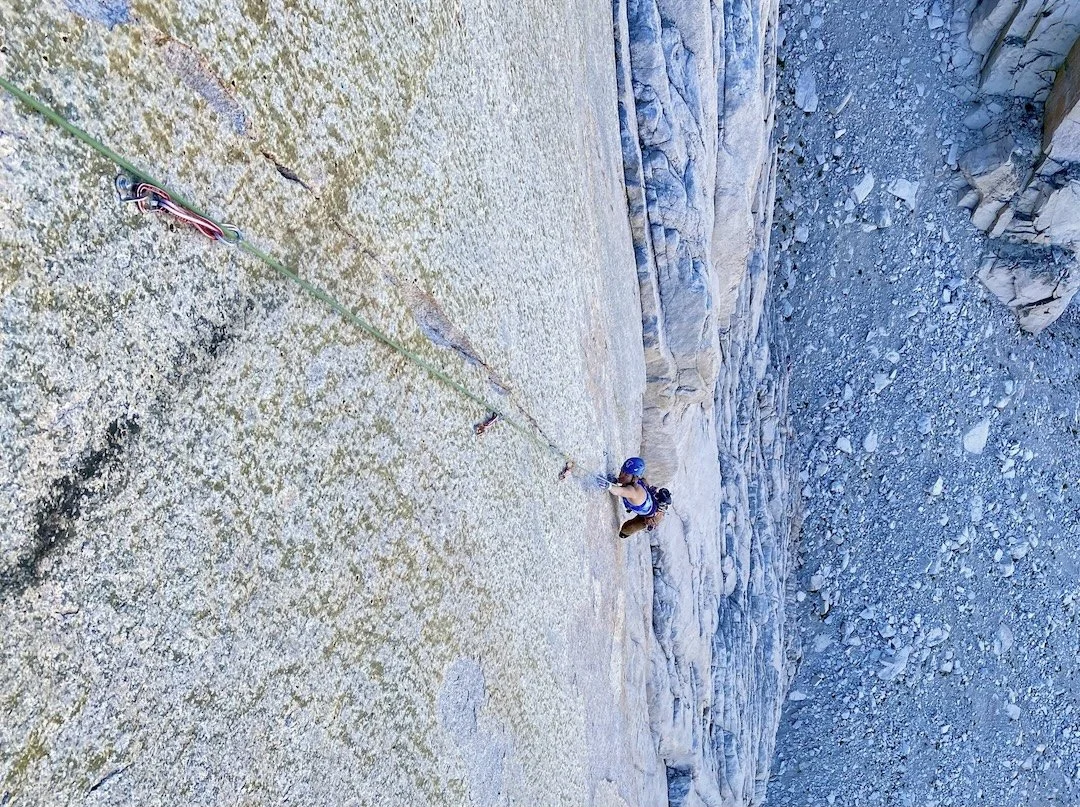Chelsea Kyffin and Jessica Perez jogging to warm up near the World Cup competition structure in Champagny-en-Vanoise, France. PC: Ryan McCauley
By Ryan McCauley (she/her)
“I mean this in the nicest way possible,” my teammate Marian Prather said, hesitating to finish their sentence. “But this experience kind of reminds me of helping my Mom with social media.” I erupted with laughter as I glared at my iPhone screen in the middle of a South Korean coffee shop, mouth agape, processing the newly learned fact that it was impossible to edit a posted Instagram story (that I had just spent 45 minutes carefully crafting with a lot of hand-holding from Marian and another friend on the USA Women’s Ice Climbing Team). I wrinkled my nose and jokingly prodded back, “Your Mom sounds cool. Is she also 35?”
This was Ryan's third and final speed run in women's finals in the World Cup in Saas-Fee, Switzerland. PC: UIAA Livestream
It was honestly the first time that weekend that I had truly relaxed, given myself permission to sit with the ridiculousness of the moment, and allowed joy to creep in. I had been too busy focusing on the pressure of my performance expectations at the first UIAA Ice Climbing World Cup of the ‘22-’23 season. Sadly, this anxiety was quickly replaced by disappointment as the results started rolling in. Nothing like training for months and flying across the world, only to fall off one swing into the speed climbing competition or slip off a lead move I had done numerous times at the training gym back home, to make me question my efforts. Although it was only my second season competing, my hopes had exceeded reality. Beginner or not, I should have done better.
If I was being honest with myself, the desire to make my Instagram story perfect by zooming in on every detail was representative of more than just my mindset at the South Korean World Cup. As a woman who has been drawn to sports historically dominated by athletes identifying as male, I have often leveraged perfectionism as a way to prove that I am good enough to belong in a given space. Asking for help is something I’ve learned to avoid at all costs. I have a tendency to approach other women with a slight hesitation or skepticism—as I try to assess how others might compare my performance to hers. Vulnerability is something I don’t share easily.
Ryan climbing in Women's speed climbing finals in the World Cup in Champagny-en-Vanoise, France. PC: Nils Paillard
So, it was intentional that my first-time dry tooling (the nuanced, competition-version of ice climbing) was at a Ladies’ Night at the Ice Coop dry-tooling gym in Boulder, which was the only facility of its kind in the U.S. at the time. I did not want to be a total novice in front of men. Beyond being male-dominated, it was also a sport nobody had ever heard of.
I joked that I was going to the hardware store when trying to explain the concept to others. Even presenting it as “indoor mixed climbing” seemed to fall flat for many. Traversing climbing routes by hooking ice tools on plastic or metal rock climbing holds was hard to comprehend. Kicking into plywood walls with specialized crampons to simulate ice climbing was confusing to visualize. And doing it all in a bouldering format at the Ice Coop without ropes seemed downright dangerous. But there was something about the challenge that hooked me. The promise of what was possible was too enthralling to ignore as I watched old YouTube videos of experienced athletes hanging upside down from swinging boxes during the 2019 UIAA Ice Climbing World Cup in Denver. However, even with this excitement, I swindled a coworker to go with me that first night so I didn’t have to risk looking like a fool in front of a group of strangers. Beginner or not, I was not going to embarrass myself.
Ryan McCauley climbing Catwoman (D10) at a dry-tooling crag in Quintal, France. PC: Justin (Jay) Jacobs
Despite my initial insecurities, that first evening dry-tooling injected an energy into me that I didn’t know existed. As a sport climber who was used to navigating routes that demanded either a lot of power or a plethora of precision, I loved how dry tooling required both. Moments that forced me to intentionally slow down my breathing and trust my exhausted arms to connect the pick of my tool with a tiny pocket on the side of a hold sent waves of enthusiasm through my entire body. I was stronger than I knew.
For the next year, I dove headfirst into every opportunity to grow and improve. I signed up for a gym membership, joined the local team, entered competitions, invested in new gear, and started attending a summer training group. Things were going well and I was excited. However, I had been so consumed with competition outcomes or team rankings to prove my “enoughness” in the sport that I hadn’t paused to reflect on the bigger picture or express gratitude for the larger value I was deriving from this space. Beginner or not, I would not allow myself to make excuses or fail.
Climbing to Not Fall
France Competition structure. PC: Ryan McCauley
If you had told me in the summer of 2021 that I would be representing the U.S. in the Ice Climbing World Cup a mere year later, I would have laughed uncontrollably. I would have rolled my eyes at the thought of re-activating my Facebook profile so I could communicate with people just over half my age to schedule team practice for a sport that had hardly any training facilities. But I also didn’t anticipate the power of the community I felt that Friday at Ladies' Night. The possibility posed by the non-judgmental, inclusive space allowed people of all ages and backgrounds to show up as total beginners and be genuinely embraced for who they were. Trust, support, and advocacy were offered to each individual who showed up and tried, no matter how guarded or hesitant they were. While resources and funding for dry tooling are more limited in the U.S. compared to some other countries, countless people are volunteering their time to expand the sport and welcome new members with open arms.
And here I was, sitting in Cheongsong, getting discouraged and fixating on my mistakes a little over a year into the sport. I couldn’t help but ruminate on how it might have played out if I could only go back in time and edit my personal story—what if I had swung the tool slightly differently; had shifted my weight at a different angle; had trained harder; had found the sport at a younger age? It still felt so hard to disconnect from the scoreboard. Beginner or not, those results defined my success.
Keenan Griscom climbing in Men's Lead Semi Finals at the France World Cup in Champagny-en-Vanoise. PC: Nils Paillard
That evening, while riding the bus back to our hotel from the competition venue, I sat next to Keenan Griscom, the top-ranked athlete on the USA Men’s Ice Climbing Team. He was just shy of his 19th Birthday and had been competing in a variety of climbing disciplines since middle school. As we debriefed the day, I was struck by the way he balanced both seriousness and lightheartedness when talking about his own performance expectations. As someone who had made finals and was slated to compete again the following day, I anticipated him to feel much more pressure than he did. Intrigued, I pummeled him with questions about his journey as an athlete, how his training had evolved, and even concerning his personal definition of success. Keeping a humble tone, Keenan noted times when a higher ranking he received didn’t elicit pride because he knew deep down that he had failed to fulfill his own potential. Similarly, he confidently recounted times when a lower score ended up being a cause for celebration because he knew within himself that he gave the competition his all.
I had noticed this same open-mindedness and curiosity earlier when someone had asked for advice on filing their picks and he had encouraged them to trust themself, experiment with an approach, and see how it went. The feisty millennial in me wanted to say something to the effect of, “It makes sense you don’t feel pressure to get it right this time, you have so many competitions ahead of you before your knees fall apart!” and it suddenly hit me. I was getting in my own way. I was the only one telling myself I had to show up perfectly now; believing that there was indeed an expiration date on this opportunity.
Keenan Griscom climbing in Men's Lead Finals at the South Korean World Cup in Cheongsong. PC: Rhea Kang
Sure, I wasn’t getting younger. And I might still never get to the same level as some of my teammates who had already been competing for nearly a decade and were 15 years my junior. But, hyperfocusing on my scores was damaging my confidence and blinding me to the massive privilege of the opportunity in front of me. Just as with the stupid Instagram story, things were already live and I couldn’t go back and update the countdown hashtags (or so I’m told— please reach out if you know otherwise) or go back in time and swing my tool into the ice tower further to the right when speed climbing. All I could do was laugh about it, remember to tag people before hitting “upload” next time, and be present with the amazing community around me at that moment.
What if I shifted the story from “What place did I get?” or “How did I compare?” to instead be about “What did I learn today to get 1% better?” “What progress can I celebrate?” or “Who did I connect with?” So much of my current narrative was driven by fear and the pressure wasn’t getting me on the podium. What if I reframed success to be about the experience rather than whether or not I fell?
Climbing to Play in the Present Moment
Ryan McCauley reaching the top of the speed wall during Women's Speed Climbing Finals in the Saas-Fee, Switzerland World Cup. PC: Robert Hendriksen
As naive as it felt, I pushed myself to focus more energy during the France World Cup on things like laughing with teammates about our “Nascar pit stop” sharing of speed crampons or joking about the record time it took my Nalgene to freeze. By the third and final competition in Switzerland, I found myself fully dancing to the music at the base of the ice tower while waiting for my turn to climb. It was the longest and steepest speed structure we had encountered so far and people were falling fairly consistently. If anything, the pressure was higher—but I had slowly started to feel gratitude for it all. “Once in a lifetime opportunity” had shifted from meaning I only had this one competition to demonstrate my entire worth to instead serving as a reminder to soak it all in. I chatted with international athletes and made silly faces at the live-stream cameras. I was going to make the most of this moment.
Suddenly, everything clicked. My tools hooked the ice smoothly one after the other and my feet glided up the wall in a delicate, nearly effortless dance. I shrieked as I turned around to look at the timer: 20.52—nearly 9 seconds off my last run and a time that would put me in 4th place overall. I guess this approach wasn’t so silly after all. I’d be lying if I said it was easy to sustain this mentality in a high-pressure competition, that it looked the same for every athlete, or that it didn’t take the same kind of practice as showing up to training each week. But, wow, it made the effort so much more worthwhile and fun. Beginner or not, letting go of my fixation on the outcome could result in a more lasting definition of success.
Reflecting on the Season
USA athletes cheering on teammates in lead finals during the South Korean World Cup in Cheongsong. From left to right - Jessica Perez, Noah Bergman, Sam Serra, Marian Prather, Dominic Gonzalez-Padron. PC: Rhea Kang
Overall, as a Team, the U.S. walked away with one of the most successful seasons we have had in the past few years. There were a lot of milestones to celebrate, such as Cat Shirley setting a record for the first-ever American woman to qualify for UIAA World Cup lead finals or Keenan Griscom earning 4th and 5th place, respectively, for lead climbing in two of the World Cups! (*see box below for more specifics).
Perhaps even more exciting to see was how much closer our community became through the shared experiences of relentless months of training, hectic or jet-lagged travel, competition stressors or mistakes, celebrations of personal or team growth, and unexpected memories made. Early morning group warm-up runs, aggressive games of Taco Cat Goat Cheese Pizza back at the Airbnb, and hugs from other athletes after emotional moments of doubt are the things that will stick with me for years to come.
There is still so much work that needs to be done in the United States to help strengthen our reputation as a competitive team and develop the sport of dry-tooling. There were moments where we jokingly noted how dry tooling was a “real sport” in other countries as we came across a multitude of gyms in Seoul where we could train and found celebrity-style posters of dry-tooling athletes in the local tourist office. It could have been tempting to be frustrated by how far behind the U.S. is concerning this, but many teammates also commented on how incredible it was to be at the frontier of this sport in our country, helping to build a stronger foundation alongside organizations like the American Alpine Club and Rab.
Justin (Jay) Jacobs warming up on the dry-tooling warm-up wall at the World Cup in Champagny-en-Vanoise, France. PC: Sam Montgomery
We may not be able to successfully revolutionize the future of dry tooling in the U.S. overnight. However, this season taught me so much about the power of giving ourselves permission to embrace the imperfections and be patient with growth. The acceptance and vulnerability that comes with this approach allows us to clearly see our own strengths and empathetically show up for others. We get to choose to contribute to success that is bigger than ourselves and accelerate our growth with each mistake. Beginner or not, letting go can actually magnify the power of our team.
Some of the specific USA women’s achievements worth noting include:
Cat Shirley (right) congratulating Roz Reynolds (left) on qualifying for Women's Lead Semi Finals at the South Korean World Cup in Cheongsong. Sam Serra is standing in between the women and Noah Bergman is off to the right. PC: Rhea Kang
South Korea:
Jessica Perez & Roz Reynolds competed in their first-ever World Cup competition!
Cat Shirley & Roz Reynolds reached the top of the lead climbing qualification routes and continued on to compete in the semi-finals, placing 8th and 16th respectively, out of a field of 31 female athletes. Cat is the first US woman to ever qualify for the UIAA World Cup lead finals!
Cat Shirley, Marian Prather, & Roz Reynolds progressed to speed climbing semi-finals, ultimately placing 3rd, 8th, and 11th respectively, out of a field of 25 female athletes. Cat walked away with a bronze medal for this performance!
Champagny-en-Vanoise:
Chelsea Kyffin competed in her first-ever World Cup competition!
Jessica Perez, Chelsea Kyffin, & Ryan McCauley climbed in temperatures of 8 degrees Fahrenheit each day during women’s lead qualifications and still made gains between their first and second routes averaging about three quickdraws higher!
Ryan McCauley & Chelsea Kyffin competed in women’s speed finals and shaved off a combined 10 seconds on their runs as they placed 7th and 14th respectively, out of a field of 16 women.
Saas-Fee:
Gabrielle (Phoebe) Tourtellotte competed in her first-ever World Cup competition!
Ryan McCauley & Lauren Shartell earned spots in women’s speed finals and placed 4th and 8th, out of a field of 21 women. With scores in all three competitions, this put Ryan in a tie for 6th place in overall women’s 2023 World Cup speed standings!
Some of the specific USA men’s achievements worth noting include:
Keenan Griscom working out the sequence for Men's Lead finals at the South Korean World Cup in Cheongsong. PC: Rhea Kang
South Korea:
Sam Serra, Ian Wedow, Daniel Koepke, Noah Bergman & Dominic Gonzalez-Padron competed in their first-ever World Cup competition!
Keenan Griscom & Tyler Kempney progressed to lead climbing semi-finals with Tyler successfully reaching the top of one lead qualification route and Keenan topping both. Keenan further advanced to lead climbing finals and the two athletes ultimately placed 4th and 10th, respectively, out of a field of 37 male athletes.
Sam Serra progressed to speed climbing semi-finals, ultimately placing 14th out of a field of 26 male athletes.
Champagny-en-Vanoise:
Noah Rowley & Justin (Jay) Jacobs competed in their first-ever World Cup competition!
Keenan Griscom progressed to lead climbing semi-finals, ultimately placing 11th out of a field of 56 male athletes.
Noah Rowley progressed to speed-climbing semi-finals, ultimately placing 14th out of a field of 37 male athletes.
Saas-Fee:
Erik Gomez competed in his first-ever World Cup competition!
Sam Serra, Noah Bergman, & Keenan Griscom all successfully reached the top of one of the two lead climbing qualification routes.
Noah Bergman & Keenan Griscom progressed to lead climbing semi-finals, with Keenan advancing to lead climbing finals. The two athletes ultimately placed 13th and 5th respectively, out of a field of 49 male athletes.
Sam Serra progressed to speed climbing finals, ultimately placing 12th out of a field of 35 male athletes.





















